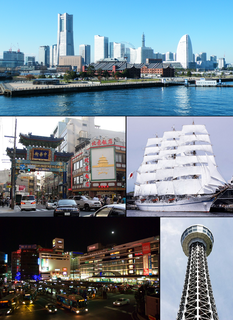
The Shin-Yokohama Raumen Museum is a food court which opened in 1994, located in the Shin-Yokohama district of Kōhoku-ku, Yokohama, Japan.

The Yokohama Curry Museum was a restaurant and historic museum of curry in the Isezakichō district of the port city of Yokohama, Japan, between 2001 and 2007. Different types of curry were available from a selection or restaurants, ranging from a full meal to a quick taste option.
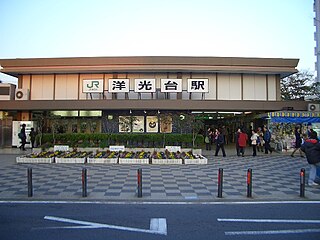
Yōkōdai Station is a railway station operated by JR East's Negishi Line located in Isogo-ku, Yokohama, Japan. It is 14.1 kilometers from the terminus of the Negishi Line at Yokohama Station and 58.5 kilometers from the terminus of the Keihin-Tōhoku Line at Ōmiya Station.

Minatomirai Station is an underground railway station on the Minatomirai Line in Nishi-ku, Yokohama, Kanagawa Prefecture, Japan, operated by the third-sector railway operating company Yokohama Minatomirai Railway.

The NHK Spring Mitsuzawa Football Stadium is a football stadium in Kanagawa-ku, Yokohama, Japan. It serves as a home ground of Yokohama FC and, on occasion, Yokohama F. Marinos. Until 1999 it had been the home of Yokohama FC's spiritual predecessor, Yokohama Flügels, and also, on occasion, to Kawasaki-based NKK FC The stadium holds 15,046 people.

The Port of Yokohama is operated by the Port and Harbor Bureau of the City of Yokohama in Japan. It opens onto Tokyo Bay. The port is located at a latitude of 35.27–00°N and a longitude of 139.38–46°E. To the south lies the Port of Yokosuka; to the north, the ports of Kawasaki and Tokyo.

Yokohama Cultural Gymnasium is an indoor sports arena located in Naka-ku, Yokohama, Japan. The capacity of the arena is 5,000 people and was opened in 1962.

The Yokohama Red Brick Warehouse is a historical building that is used as a complex that includes a shopping mall, banquet hall, and event venues. The complex, officially known as the Newport Pier Tax Keeping Warehouse, was originally used as customs buildings, and has two sections: Warehouse No.1 and No.2. It is operated by Yokohama Akarenga Co. Ltd., and located at the Port of Yokohama in Naka-ku, Yokohama, Kanagawa, Japan.
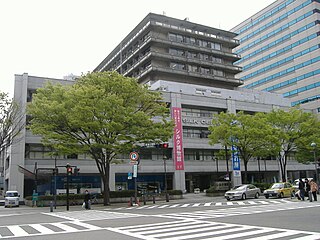
Yokohama Silk Museum is a museum located in Naka-ku, Yokohama, Japan that covers the silk trade in Japan. The museum displays silk kimonos and covers the importance of Yokohama as a silk port.
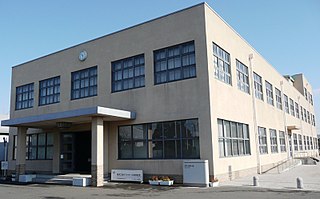
The Nissan Engine Museum is an automobile engine museum run by Nissan Motor Company. The museum is located at the first floor of the guest hall in Yokohama auto plant, Kanagawa-ku, Yokohama, Japan.

Yokohama Museum of Art, founded in 1989, is located in the futuristic Minato Mirai 21 district of the Japanese city Yokohama, next to the Yokohama Landmark Tower.

Yokohama Science Center is a science museum in Isogo-ku, Yokohama, Kanagawa, Japan.

Yokohama History Museum is a history museum in Tsuzuki-ku, Yokohama, Kanagawa, Japan. Its exhibition focuses on the history of the city of Yokohama.

The Tsurumi River is a river in Kanagawa and Tokyo Prefectures on Honshū, Japan. It begins at the confluence of the Onda and Yamoto rivers in Yokohama and flows 22 kilometers before emptying into Tokyo Bay.
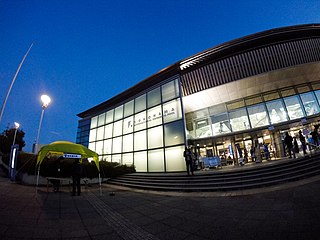
Yokohama International Swimming Pool is a swimming venue in Yokohama, Japan. The main pool is converted to a basketball arena in fall and winter by setting up panels on the floor. This arena is home of the B.League basketball club Yokohama B-Corsairs.
Shin-Yokohama is a small district in Kōhoku-ku, Yokohama, Kanagawa Prefecture, Japan.

The Japan Coast Guard Museum Yokohama is a museum in Naka-ku, Yokohama, Kanagawa Prefecture, Japan, dedicated to maritime security and the Japan Coast Guard. It opened on 10 December 2004.

Nippon Maru (日本丸) is a Japanese museum ship and former training vessel. She is permanently docked in Yokohama harbor, in Nippon Maru Memorial Park.

Kanagawa Prefectural Museum of Cultural History also known as the Yokohama Museum of Cultural History is a history museum in Naka-ku, Yokohama, Kanagawa, Japan.

Meiji Maru (明治丸) is a Japanese sailing ship that serves as a museum ship in Tokyo. It is displayed at the Etchujima Campus of the Tokyo University of Marine Science and Technology.


